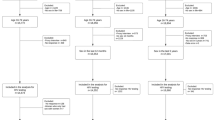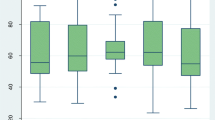Abstract
Aim
To investigate the associations between self-reported condom use and HIV, sexually transmitted infections (STIs) and pregnancy rates among women who enrolled in HIV biomedical intervention trials in South Africa.
Subjects and Methods
Data from 9948 women were analysed. Cox regression models were used to assess the associations between condom use and primary outcomes.
Results
Overall HIV, STI and pregnancy incidence rates were 7, 15 and 9 per 100 person/year. Women reporting condom use (65%) at last sex were younger, had more schooling, had fewer children and were more likely to be single/non-cohabiting, and hormonal injectables were the most common family planning method among women who reported using a condom at last sex. They were at increased risk of HIV (adjusted hazard ratio (aHR) 1.23, 95% CI 1.07, 1.43), STI (aHR 1.20, 95% CI 1.05, 1.34) and pregnancy (aHR 1.23, 95% CI 1.10, 1.40).
Conclusion
In this population, self-reported condom users were identified as a proxy for a combination of high-risk sexual behaviours. They were associated with increased risks of HIV, STI and pregnancy incidence rates. These counterintuitive findings broadly indicate the women’s correct perception about their risky sexual behaviours which may have led them to use condoms. Our findings can have significant implications in clinical research settings by assisting in recruitment and monitoring strategies.
Similar content being viewed by others
Data availability statement
No further data are available without ethical approvals.
References
Abdool Karim Q, Abdool Karim SS, Frohlich JA, Grobler AC, Baxter C, Mansoor LE et al (2010) Effectiveness and safety of tenofovir gel, an antiretroviral microbicide, for the prevention of HIV infection in women. Science 329:1168–1174
Abbai NS, Wand H, Ramjee G (2013) Sexually transmitted infections in women participating in a biomedical intervention trial in Durban: prevalence, coinfections, and risk factors. J Sex Transm Dis 358402. https://doi.org/10.1155/2013/358402
Adetunji J, Meekers D (2001) Consistency of condom use in the context of AIDS in Zimbabwe. J Biosocial Sci 33(1):121–138
Baeten JM, Palanee-Phillips T, Brown ER, Schwartz K, SotoTorres LE, Govender V, Mgodi NM, Kiweewa FM, Nair G, Mhlanga F, Siva S, Bekker LG, for the MTN-020-ASPIRE Study Team (2016) Use of a vaginal ring containing dapivirine for HIV-1 prevention in women. N Engl J Med. https://doi.org/10.1056/NEJMoa1506110
Balkus JE, Brown E, Palanee T, Nair G, Gafoor Z, Zhang J, Richardson BA, Chirenje ZM, Marrazzo JM, Baeten JM (2016) An empiric HIV risk scoring tool to predict HIV-1 acquisition in African women. J Acquir Immune Defic Syndr 72(22):333–343
Brown JL, Sales JM, DiClemente RJ, Salazar LF, Vanable PA, Carey MP, Brown LK, Romer D, Valois RF, Stanton B (2012) Predicting discordance between self-reports of sexual behavior and incident sexually transmitted infections with African American female adolescents: results from a 4-city study. AIDS Behav 16(6):1491–1500. https://doi.org/10.1007/s10461-012-0163-8
Christina L, Allen S, Caraël M (1991) Knowledge, attitudes and perceived risk of AIDS among urban Rwandan women: Relationship to HIV infection and behavioral change. AIDS 5(8):993–1,002
Dunkle K (2004) Transactional sex among women in Soweto, South Africa: prevalence, risk factors and association with HIV infection. Soc Sci Med 59(8):1581–1592
DiClemente RJ, Swartzendruber AL, Brown JL (2013) Improving the validity of self-reported sexual behavior: no easy answers. Sex Transm Dis 40(2)111–112. https://doi.org/10.1097/OLQ.0b013e3182838474
Harrison A, Cleland J, Frohlich J (2008) Young people’s sexual partnerships in KwaZulu-Natal, South Africa: patterns, contextual influences, and HIV risk. Stud Fam Plan 39:295–308. https://doi.org/10.1111/j.1728-4465.2008.00176.x
Heffron R, Parikh UM, Penrose KJ, Mugo N, Donnell D, Celum C et al (2017) Objective measurement of inaccurate condom use reporting among women using depot medroxyprogesterone acetate for contraception. AIDS Behav 21:2173–2179. https://doi.org/10.1007/s10461-016-1563-y
Joint United Nations Programme on HIV/AIDS (UNAIDS) (2017) UNAIDS Data 2017. Available from: http://www.unaids.org/sites/default/files/media_asset/20170720_Data_book_2017_en.pdf. Accessed 3 November 2019
Luke N (2003) Age and economic asymmetries in the sexual relationships of adolescent girls in sub-Saharan Africa. Stud Fam Plann 34(2):67–86 40
Maharaj P, Cleland J (2004) Condom use within marital and cohabiting partnerships in KwaZulu-Natal, South Africa. Stud Fam Plann 35(2):116–124
Maharaj P (2005) Patterns of condom use: perspectives of men in KwaZulu-Natal, South Africa. Dev South Afr 22(2):187–197
Marrazzo JM, Ramjee G, Richardson BA, Gomez K, Mgodi N, Nair G, Chirenje ZM (2015) Tenofovir-based preexposure prophylaxis for HIV infection among African women. New Eng J Med 372(6):509–518
McCormack S, Ramjee G, Kamali A, Rees H, Crook AM, Gafos M, Weber J (2010) PRO2000 vaginal gel for prevention of HIV-1 infection (microbicides development Programme 301): a phase 3, randomised, double-blind, parallel-group trial. Lancet 376:1329–1337. https://doi.org/10.1016/S0140-6736(10)61086-0
Minnis AM, Steiner MJ, Gallo MF, Warner L, Hobbs MM, van der Straten A, Chipato T, Macaluso M, Padian NS (2009) Biomarker validation of reports of recent sexual activity: results of a randomized controlled study in Zimbabwe. Am J Epidemiol 170(7):918–924
Naidoo S, Wand H, Abbai NS, Ramjee G (2014) High prevalence and incidence of sexually transmitted infections among women living in Kwazulu-Natal. South Africa AIDS Res Ther 11:31. https://doi.org/10.1186/1742-6405-11-31
Padian NS, van der Straten A, Ramjee G, Chipato T, de Bruyn G, Blanchard K et al (2007) Diaphragm and lubricant gel for prevention of HIV acquisition in southern African women: a randomised controlled trial. Lancet 370:251–261. https://doi.org/10.1016/S01406736(07)60950-7
Ramjee G, Dassaye R, Reddy T, Wand H (2018) Targeted pregnancy and human immunodeficiency virus prevention risk-reduction counseling for young women: lessons learned from biomedical prevention trials. J Infectious Dis 218(11):1759–1766. https://doi.org/10.1093/infdis/jiy388
Ramjee G, Wand H, Whitaker C, McCormack S, Padian N, Kelly C, Nunn A (2012) HIV incidence among non-pregnant women living in selected rural, semi-rural and urban areas in Kwazulu-Natal, South Africa. AIDS Behav 16(7):2062–2071
Shisana O, Rehle T, Simbayi LC et al (2005) South African national HIV prevalence, HIV incidence, behaviour and communication survey 2005. HSRC Press, Cape Town
Shisana O, Rehle T, Simbayi LC, Zuma K, Jooste S, Zungu N et al (2014) South African national HIV prevalence, incidence and behaviour survey, 2012. HSRC Press, Cape Town
Skoler-Karpoff S, Ramjee G, Ahmed K, Altini L, Plagianos M, Friedland B (2008) Efficacy of Carraguard for prevention of HIV infection in women in South Africa: a randomised, double-blind, placebo-controlled trial. Lancet 372:1977–1987. https://doi.org/10.1016/S0140-6736(08)61842-5
Tanser F, Bärnighausen T, Dobra A, Sartorius B (2017) Identifying ‘corridors of HIV transmission’ in a severely affected rural South African population: a case for a shift toward targeted prevention strategies. Int J Epidemiol 47(2):537–549
Tanser F, Hosegood V, Bärnighausen T, Herbst K, Nyirenda M, Muhwava W, Newell ML (2007) Cohort profile: Africa Centre demographic information system (ACDIS) and population-based HIV survey. Int J Epidemiol 37(5):956–962 37
Wand H, Ramjee G (2017) Identifying factors associated with low-adherence and subsequent HIV seroconversions among south African women enrolled in a biomedical intervention trial. AIDS Behav 21:393–401. https://doi.org/10.1007/s10461-016-1471-1
Wand H, Ramjee G (2012) The effects of injectable hormonal contraceptives on HIV seroconversion and on sexually transmitted infections. AIDS 26:375–380. https://doi.org/10.1097/QAD.0b013e32834f990f
Wand H, Reddy T, Naidoo S, Moonsamy S, Siva S, Morar NS, Ramjee G (2018) A simple risk prediction algorithm for HIV transmission: results from HIV prevention trials in KwaZulu Natal, South Africa (2002–2012). AIDS Behav. https://doi.org/10.1007/s10461-017-1785-7
Wand H, Morris N, Reddy T (2020a) Characteristics of women who use hormonal contraceptives and their population-level impacts on HIV infection in a cohort of south African women (2002–2016). Eur J Contraception Reproductive Health Care 25:449–455. https://doi.org/10.1080/13625187.2020.1831469
Wand H, Reddy T, Dassaye R, Moodley J, Naidoo S, Ramjee G (2020b) Estimating prevalence and incidence of sexually transmitted infections among south African women: implications of combined impacts of risk factors. Int J STD AIDS 31:1093–1101. https://doi.org/10.1177/0956462420915388
Wand H, Morris N, Reddy T (2021a) Temporal and spatial monitoring of HIV prevalence and incidence rates using geospatial models: results from south African women. Spatial Spatio-Temporal Epidemiol 37. https://doi.org/10.1016/j.sste.2021.100413
Wand H, Ramjee G, Reddy T (2021b) Quantifying geographical diversity in sexually transmitted infections using population attributable risk: results from HIV prevention trials in South Africa. Int J STD AIDS 32:600–608. https://doi.org/10.1177/0956462420968998
Acknowledgements
The current study used the secondary sub-group data from a study supported by the President’s Emergency Plan for AIDS Relief (PEPFAR) through the Centers for Disease Control and Prevention (CDC) under the terms of 3U2GGH000570 and the South African National AIDS Council (SANAC). All the views in this study are solely the responsibility of the authors and do not necessarily represent the official views of CDC or SANAC. For the Clinic-based data, we used the site-specific secondary (subgroup) data and did not receive any funding. The authors did not receive any funding for the current study. However, we acknowledge that main studies associated with these trials have received funding and support from the various sources including: the UK Department for International Development and the Medical Research Council (MDP Feasibility Study: Grant number G0100137); the Bill & Melinda Gates Foundation (MIRA: Grant number 21,082).
Funding
The authors did not receive any funding for the current study.
Author information
Authors and Affiliations
Contributions
HW and TR participated in the design of the study and performed the statistical analysis. NM and TR extracted and merged the data. HW drafted the manuscript. HW, TR and NM interpreted the results. All authors read and approved the final manuscript.
Corresponding author
Ethics declarations
The authors have no disclosures to report.
Conflict of interest
The author(s) declare that they have no competing interests.
Ethical considerations
Ethical approvals were received from the Research Ethics Committee of the Human Sciences Research Council, South Africa (REC: 5/17/11/10); the Associate Director of Science of the National Centre for HIV and AIDS, Viral Hepatitis, STD and TB Prevention at the USA’s CDC in Atlanta, Georgia, USA. The study protocol has received by the Human Sciences Research Council (HSRC) Research Ethics Committee (REC: 5/17/11/10) and by the Centers for Disease Control and Prevention. In addition, the principle investigators of the study have received additional approval from the SABSSM data curation team on June 5, 2018. For the clinic-based data: Ethical approval for the trials, including all study protocols and informed consent forms, were received from the University of KwaZulu-Natal Biomedical Research Ethics Committee and the South African Medical Research Council Ethics Committee; the University of Cape Town Research Ethics Committee; and the South African Medicines Control Council as well as the various study-specific Institutional Review Boards.
Informed consent
Study participants who enrolled in these studies provided either written or verbal consent. Participants confirmed their consent by signature or witnessed thumbprint.
Additional information
Publisher’s note
Springer Nature remains neutral with regard to jurisdictional claims in published maps and institutional affiliations.
Supplementary Information
ESM 1
(PDF 72 kb)
Appendix
Appendix
Rights and permissions
About this article
Cite this article
Wand, H., Morris, N. & Reddy, T. Understanding the public health implications of self-reported condom use in HIV clinical trials: lessons learned in KwaZulu Natal, South Africa (2002–2016). J Public Health (Berl.) 31, 1113–1120 (2023). https://doi.org/10.1007/s10389-021-01639-2
Received:
Accepted:
Published:
Issue Date:
DOI: https://doi.org/10.1007/s10389-021-01639-2




